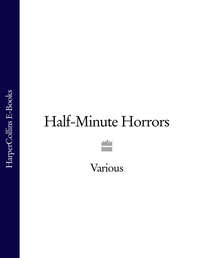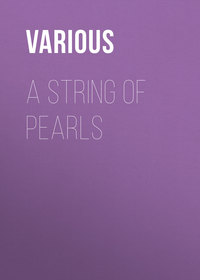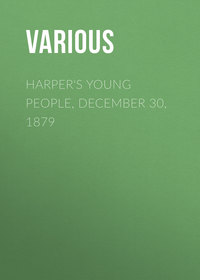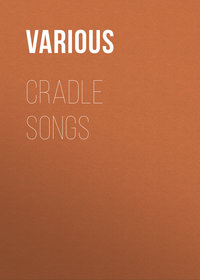![Birds Illustrated by Color Photography [January, 1898]](/covers_330/25570847.jpg)
Birds Illustrated by Color Photography [January, 1898]

Various
Birds Illustrated by Color Photography [January, 1898] A Monthly Serial designed to Promote Knowledge of Bird-Life
INTRODUCTION
With the January number of Birds, we enter upon a new year with the satisfaction of having pleased our readers, as well as rendered an actual service to the cause of education, ornithological literature, and art. Among the hundreds of testimonials from competent judges, (many of them scientists), which we have received, we will permit ourselves the use of one only, as exemplifying the excellence which we have sought to attain and the rightful claim which we may make for the future. The writer says: “I find Birds an everlasting source of pleasure to the children, not less than to myself. I have one of the few almost absolutely fresh copies of ‘Audubon’s Birds,’ for which I have refused $3,000, besides later works, and I will say that the pictures of birds given in your magazine are infinitely more true to life, and more pleasing, everyway, than any of those presented in either work. The other day I compared some of your pictures with the birds mounted by myself, notably a Wood-duck and a Wood-cock, and every marking co-incided. The photographs might have been taken from my own specimens, so accurately were they delineated, attesting the truth of your work.”
Some of our subscribers, unaware of the prodigality with which nature has scattered birds throughout the world, have asked whether the supply of specimens may not soon be exhausted. Our answer is, that there are many thousands of rare and attractive birds, all of them interesting for study, from which, for years to come, we might select many of the loveliest forms and richest plumage. Of North American birds alone there are more than twelve hundred species.
The success of Birds is due to its superior color illustrations and the unique treatment of the text. Popular and yet scientific, it is interesting to old and young alike.
The classification and nomenclature followed are those adopted by the American Ornithological Union in 1895.
Nature Study Publishing Company.THE PIGEONS
Under the big nursery tableAre Sue, Don, Harold, and Mabel,All playing, with joy and delight,That pigeons they are, dressed in white.Don’t you hear their gentle “coo, coo”?Ah, now they fly out in full view!And over the meadow they go —’Tis their own dear nursery, you know —Where, quick to the tops of the treesThey fly, with lightness and ease;There each birdie is glad to bePerched high upon a big chair-tree.But to their home in swiftest flightThey haste, ere day has changed to night;Then in they go, with cooing sweet,And find their home a blest retreat.And now they tell just where they’ve been,And all the wondrous sights they’ve seen.Then with their “coo, coo,” soft and low,Each pigeon goes to sleep, I trow.– Emma G. Saulsbury.THE CROWNED PIGEON
WE regret that a full monograph of this remarkable bird cannot be given in this number. It is the giant among Pigeons and has some characteristics, on account of its great size, not common to the family. Very little has been written about it, and it would be a real service to ornithology if some one familiar with the subject would communicate his knowledge to the public. These birds pair for life, and the loss or death of a mate is in many cases mourned and grieved over, the survivor frequently refusing to be consoled.
The Pigeon family is an exceedingly interesting one, of great variety of form and color, undergoing constant change by inter-breeding. There are about three hundred known species of Pigeons and Doves, about one third of which number are found in the New World. In North America but twelve species occur, a family small enough to find room in Birds to sit for their pictures. Some of these birds, says Chapman, are arboreal, others are strictly terrestrial. Some seek the forests and others prefer the fields and clearings. Some nest in colonies, others in isolated pairs, but most species are found in flocks of greater or less size after the nesting season. When drinking, they do not raise the head as others do to swallow, but keep the bill immersed until the draught is finished. The young are born naked and are fed by regurgitation.
Living specimens of this the largest species of Pigeons may some day be brought to the United States and made to increase as the Ring-necked English Pheasant has already been domesticated in their own country. It has been suggested that their introduction among us would be a comparatively easy matter.
THE RED-EYED VIREO
“A bird with red eyes! look, mamma,” said Bobby. “How funny!”
“And how beautiful,” replied his mamma. “Not plainly dressed, like his cousin, the Warbling Vireo, whose picture you saw in the October number of Birds.”
“The Yellow-Throated, in the June number,” said Bobbie, who has a remarkable memory, “was a lovely bird, too, mamma. Can Mr. Red-eye sing?”
“No, you can’t call his note a song; it is more like a chatter, which he keeps up from morning till night.”
“Like some children,” said Bobbie, with a sage nod of the head, “who talk all day long.”
“Yes,” smiled his mamma, “without saying very much, either. But this little bird works while he chatters.”
“I reckon he stops at noon time,” said Bobbie, “as other birds do.”
“No, even then the silence of the woods is broken by the Red-eyed Vireo’s voice. He is such a busy little fellow, he can’t find time for a nap.”
“Hm!” remarked Bobbie; “the other birds must find him a tiresome fellow, I think.
“Has he any other names, mamma?”
“Yes, he is called the Red-eyed Greenlet or Red-eyed Fly-catcher. One gentleman calls him ‘The Preacher.’ To him the bird seems to say, ‘You see it; you know it; do you hear me? do you believe it?’”
“I’m going to look out for that red-eyed preacher next summer,” said Bobby, with a laugh.
“One lady who makes a study of birds thinks he says, ‘I know it! would you think it? musn’t touch it; you’ll rue it!’ He makes a pause, as you see, after each sentence.”
“Tell me something about their nests?” said Bobbie, deeply interested.
“They are made of bark fibers, cobwebs, bits of paper, and scraps of hornets’ nests, in the form of a little pocket. This is suspended from the fork of two or more twigs high up in the tree, making a sort of cradle for the little ones.”
“Rock-a-by, baby, on the tree top,When the wind blows, the cradle will rock.”hummed Bobby. “How jolly!”
“Yes,” said mamma; “and they take care that it is under some green leaves, which act as an umbrella to keep the sun out of the mother’s eyes while she sits on the four pretty white eggs.”
“And out of the little ones’ red eyes, too,” laughed Bobbie. “How cute!”
THE RED EYED VIREO
RED-EYED VIREO, Red-eyed Greenlet, and Red-eyed Fly-catcher are the names variously applied to this pretty representative of his family, of which there are about fifty species. The Red-eye is an inhabitant of Central America and Mexico, its northern limit being the lower Rio Grande valley in Texas.
The exquisite little creature is tinted even more delicately than the Wax-wing, but with much the same glossy look and elegant air. The ruby-tinted eye, and the conspicuous white line above it, with its border, are good characteristics by which to distinguish it from its relatives.
The Red-eyed Vireo is found alike in the shade trees of lawns, in orchards or woodlands, and is especially fond of sycamore groves along streams. The male is a tireless songster, and even at noon-tide of a sultry summer-day, when all other warblers are silent, his monotonous song will be heard. He-ha-wha, or he, ha, whip, in rising inflection, and he, ha, whee, in falling cadence. He has also a chip, a chatter like a miniature of the Oriole’s scold, heard only in the season of courtship, and a peculiarly characteristic querulous note which, like others, can not be described with accuracy.
“The Preacher,” a name which Wilson Flagg has given this Vireo, exactly reflects the character of the bird and its song. “His style of preaching is not declamation,” says the writer. “Though constantly talking, he takes the part of a deliberate orator who explains his subject in a few words and then makes a pause for his hearers to reflect upon it. We might suppose him to be repeating moderately, with a pause between each sentence, ‘You see it – You know it – Do you hear me? – Do you believe it?’ All these strains are delivered with a rising inflection at the close, and with a pause, as if waiting for an answer.”
From morning till night this cheery bird sings as he works, from May to September. “His tender and pathetic utterances,” says Brewer, “are in striking contrast to the apparent indifference or unconsciousness of the little vocalist who, while thus delighting the ear of the listener, seems to be all the while bent on procuring its daily food, which it pursues with unabated ardor.”
As noxious and destructive insects constitute the Vireo’s chief food he may properly be classed among the beneficent birds. Seeking for these is his constant occupation, as he hops along a branch, now peering into some crevice of the bark or nook among the foliage, ever uttering his pretty song during the interval between swallowing the last worm and finding the next.
The nest of the Red-eye is built in a horizontal branch of a tree, usually in a small sapling that responds to all the caprices of the wind, thus acting as a cradle for the little ones within. The nest is cup-like in shape, and always dependent from small twigs, around which its upper edges are firmly bound, with a canopy of leaves overhead. It is woven of a variety of materials, fine strips of bark, fibres of vegetables, and webs of spiders and caterpillars. It is said that two nests of the same species are rarely found alike. Some are built of paper fibres, and bits of hornets’ nests, and another may be a perfect collection of scraps of all sorts.
The eggs are three or four, white with a few black or umber specks about the larger end.
It was in the nest of the Red-eyed Vireo that Hamilton Gibson found twisted a bit of newspaper, whose single legible sentence read: “* * * have in view the will of God.”*
THE EARLY OWL
An Owl once lived in a hollow tree,And he was as wise as wise could be.The branch of learning he didn’t knowCould scarce on the tree of knowledge grow,He knew the tree from branch to root,And an owl like that can afford to hoot.And he hooted – until, alas! one day,He chanced to hear, in a casual way,An insignificant little birdMake use of a term he had never heard.He was flying to bed in the dawning lightWhen he heard her singing with all her might,“Hurray! hurray! for the early worm!”“Dear me,” said the owl, “what a singular term!I would look it up if it weren’t so late,I must rise at dusk to investigate.Early to bed and early to riseMakes an owl healthy, and stealthy, and wise!”So he slept like an honest owl all day,And rose in the early twilight gray,And went to work in the dusky lightTo look for the early worm at night.He searched the country for miles around,But the early worm was not to be found;So he went to bed in the dawning lightAnd looked for the “worm” again next night.And again and again, and again and again,He sought and he sought, but all in vain,Till he must have looked for a year and a dayFor the early worm in the twilight gray.At last in despair he gave up the search,And was heard to remark as he sat on his perchBy the side of his nest in the hollow tree:“The thing is as plain as night to me —Nothing can shake my conviction firm.There’s no such thing as the early worm.”– O. Herford.THE FOX-COLORED SPARROW
IN “Wood Notes Wild,” S. P. Cheney says this song-loving Sparrow has a sweet voice and a pleasing song, which he has set to music. No Sparrow, he says, sings with a better quality of tone. A distinguished musician himself, no one was better qualified to give a final opinion upon the subject. Others have spoken in praise of it, Burroughs characterizing it as “a strong, richly modulated whistle, the finest Sparrow note I have ever heard.” Baird says, “in the spring the male becomes quite musical, and is one of our sweetest and most remarkable singers. His voice is loud, clear, and melodious; his notes full, rich, and varied; and his song is unequalled by any of this family that I have ever heard.” Mr. Torrey finds a “Thrush-like” quality in the song of the Fox Sparrow. In his “Birds in the Bush” Mr. Torrey describes an interesting contest as follows:
“One afternoon I stood still while a Fox Sparrow and a Song Sparrow sang alternately on either side of me, both exceptionally good vocalists, and each doing his best. The songs were of about equal length, and as far as theme was concerned were not a little alike; but the Fox Sparrow’s tone was both louder and more mellow than the others, while his notes were longer, – more sustained, – and his voice was ‘carried’ from one pitch to another. On the whole, I had no hesitation about giving him the palm; but I am bound to say that his rival was a worthy competitor.”
The Fox-colored Sparrow is also one of the largest and finest of his tribe, breeding from the Gulf of St. Lawrence and Labrador north into Alaska; in winter it is met with south over the whole of the eastern United States to the Gulf coast. Audubon found it nesting in Labrador from the middle of June to the 5th of July. Its nest has been found in trees and on the ground in the Arctic regions, on the Yukon river in July. According to many observers, the nests are, for the most part, placed on the ground, usually concealed by the drooping branches of evergreens. They are made of grass and moss, lined with fine grass and feathers. Some nests are three or four inches in depth, strong, compact, and handsome. The eggs are three or five, oval in form, of a clayey greenish ground color, dotted with dull reddish brown and chocolate. They vary in coloration.
In the early spring the Fox Sparrow is often seen associated with small parties of Juncos, in damp thickets and roadside shrubbery; later, according to Mr. Bicknell, it takes more to woodsides, foraging on leaf-strewn slopes where there is little or no undergrowth. In the autumn it is found in hedgerows, thickets and weedy grainfields, rarely however, straying far from some thickety cover. It is a great scratcher among dead leaves, and “can make the wood rubbish fly in a way which, in proportion to its size, a barn-yard fowl could scarcely excel.”
The Sparrows are worthy of close study, many of them possessing habits of great beauty and interest.
BOB WHITE!
I’m a game bird, not a song bird with beautiful feathers, flitting all day from tree to tree, but just a plain-looking little body, dressed in sober colors, like a Quaker.
It wouldn’t do for me to wear a red hat, and a green coat, and a yellow vest. Oh, no!, that would be very foolish of me, indeed. What a mark I would be for every man and boy who can fire a gun or throw a stone, as I run along the ground in clearings and cultivated fields. That’s the reason I wear so plain a coat. At the first glance you would take me for a bunch of dried grass or a bit of earth, but at the first movement, off I go, running for dear life to some thickly wooded cover, where I hide till danger is passed.
Cute! Yes, I think so. You would have to be sharp, too, if you were a game bird. Through the summer we don’t have much trouble, but just as soon as cold weather sets in, and our broods have grown to an eatable size, “pop” go the guns, and “whirr” go our wings as we fly through the air. It is only at such times we take wing, sometimes seeking refuge in a tree from our enemies. I’m sorry we are such nice birds – to eat – for really we like to stay around farmhouses, and barn-yards, eating with the chickens and other fowl. We are easily tamed, and the farmers often thank us for the injurious insects we eat, and the seeds of weeds.
How do we know they thank us? Why, we must know that, when they scatter seed for us on the snow. Kind deeds speak louder than words, for in the winter we suffer a great deal. Sometimes when it is very cold we burrow down under the snow, in snow-houses, as it were, to keep warm. That is risky, though; for when it rains and then freezes over, we are in a trap. A great many Quail die in this way during a hard winter.
Is Quail another name for Bob White? Yes, but people like Bob White better. Did you ever hear me whistle? If not, come out in the country in the spring, and hear me call to my mate. I sit on a fence rail, and, to let her know where I am, I whistle, Bob White! Bob White! and if she pretends to be bashful, and doesn’t answer me at once, I whistle again, Bob, Bob White! Poor Bob White! She takes pity on me then, and comes at my call.
BOB WHITE
BOB WHITE is a plump, fine-looking fellow, known in the New England and Middle States as the Quail and in the Southern States as the Partridge. It is said, however, that these names belong to other and quite different birds, and at the suggestion of Prof. Baird, Bob White, which is its call note, has become its accepted and present name. In the language of Mr. N. S. Goss these birds appear to thrive best in the presence of man, and were they protected during our cold winters, would soon become quite tame. They often nest near our dwellings. “In the spring of 1867,” says Mr. Goss, “I was shown on Owl Creek, Woodson County, Kansas, a nest containing nineteen eggs. It was placed in the dooryard, and not over twenty-five yards from the house; several dogs were running about the yard, and the house cat was purring near the doorway. Fearing the eggs would be destroyed, I suggested the building of a high, tight fence round the nest. ‘Oh,’ said the farmer, ‘that is not necessary; our cats and dogs will not harm them, for they know them well, as they have for a long time run about with the chickens, and feed with them from food thrown from the doorstep.’ I am confident that if man were as friendly to the birds as they are to man, they would soon become thoroughly domesticated. Trapped and hunted as they are with dog and gun it is not strange that as a whole they remain timid and mistrustful, and were they not naturally birds of civilization would rapidly disappear with the settlement of the country. As it is, they seem to realize that man is only at times their enemy, and that his cultivated fields afford them a safe refuge from many other enemies, and insure a more certain and bountiful supply of food than found elsewhere.”
Quails destroy injurious insects and seeds of weeds, upon which they largely feed. When startled they rise with a loud whirring sound, their flight being very swift, low, and direct, a rather laborious effort. They move about in small coveys or family groups, pairing during the nesting season, and share alike in the duties of protecting and rearing the young.
The nest is placed on the ground, in a depression, usually in the grass upon the prairies, sometimes in a thicket, under a low bush. It is usually arched over with grass, with entrance on the side.
From fifteen to twenty pure white eggs are usually laid.
S. P. Cheney pleasantly says: “Familiar as I have been with almost all parts of Vermont for more than thirty years, I have seen only one Quail in the state, and he was evidently a ‘tramp.’ I heard him just at night, the first day of July, 1884. Did not get sight of him till the next morning, when he came out into the sun, stood on the top rail of a fence, warmed himself, and whistled his spirited, forceful tune, his solid little body swelling and throbbing at every note, especially when he rose to the tonic. I was prepared for him, and made an exact copy of what he gave: Bob, Bob, White! Bob White! Bob, Bob, White! After the performance he stood, evidently listening for a reply; none came, and without another note he disappeared, to be seen no more.”
BIRDS IN THE SCHOOLS
THE movement to protect the birds of America and prevent them from being transformed into millinery in such prodigious numbers, is having a marked revival in many parts of the country, especially in the state of New York. In New York City there was recently held a large public meeting, under the auspices of the Audubon Society and the American Museum of Natural History, to protest against the wholesale and indiscriminate destruction of native birds for personal adornment. State Superintendent of Schools Skinner of that state has established a “bird day” in the public schools in connection with Arbor Day, in which the pupils will be taught the great value of birds to mankind. Mr. Skinner also has in preparation a manual upon the subject, 100,000 copies of which he will have distributed among the New York state schools.
Public ignorance regarding the value of birds in the economy of nature and especially to human life is so great as to be almost incomprehensible. A number of estimates recently made by Morris K. Jesup, President of the American Museum of Natural History, show how important it is that a stronger safe-guard, in the shape of public sentiment, should be thrown about our feathered benefactors. In a late interview upon this subject, Mr. Jesup said:
“Among the birds most worn this winter are the Herons, which are killed for their aigrettes; the Terns, or Sea Swallows and Gulls; in short mostly marsh and maritime birds.” It is known that the killing of a great number of these shore birds has been followed by an increase in human mortality among the inhabitants of the coast, the destroyed birds having formerly assisted in keeping the beaches and bayous free from decaying animal matter. New Orleans had a plague of bugs about the middle of September, just when the yellow fever began, and, strange as it may seem, the bugs proved far more troublesome than the disease, and certainly the annoyance was more immediate. The people called it a mystery, but the scientists said it was merely the result of man’s improvidence in destroying the birds. The destruction has been going on in Louisiana, particularly on the Gulf coast, for years, and has been carried on by professional hunters, who kill the birds solely for millinery purposes. Nature revenged herself on New Orleans, as she will on every place where birds are destroyed for fashionable purposes.
Would it not be a good thing to increase the intelligence of the present and rising generation respecting the value of birds by introducing into the schools of every state in the Union the idea which has been adopted by State Superintendent Skinner? And we respectfully suggest that the use of this magazine by teachers, through the wise co-operation of school boards, everywhere, as a text book, would quickly supply the knowledge of bird-life and utility so sadly needed by the community. We present some of the innocent creatures each month in accurate outline and color, and the dullest pupil cannot fail to be impressed by their beauty and the necessity for their protection. “Our schools, public and private, can hardly be criticised as instructors in the common branches of learning, but they could also teach the rising generation the equally important truths relating to the material world with which we are encircled.” In Colorado and in some other states Boards of Education have supplied their teachers with Birds in sufficient quantities to enable their pupils to study the subjects in the most profitable manner.
– C. C. Marble.THE PASSENGER PIGEON
IF the reader is interested in numbers, he will appreciate the statement written about 1808 by Wilson, who estimated that a flock of Wild Pigeons observed by him near Frankfort, Kentucky, contained at least 2,230,272,000 individuals. If he is also interested in the aspect presented by these birds in flight, cloud-like in form and apparently boundless in extent, he will read the full and graphic descriptions given by Audubon. In 1863, when the writer was a boy, he remembers seeing the birds brought to town in barrels and sold at a price which did not justify transportation to market. What appeared to be a cloud, dark and lowering, was not infrequently seen approaching, soon to shut out the light of the sun, until the birds which composed it, on the way to or from their feeding or roosting places, had passed on. Now hear what Major Bendire, as late as 1892, says: “It looks now as if their total extermination might be accomplished within the present century. The only thing which retards their complete extinction is that it no longer pays to net these birds, they being too scarce for this now, at least in the more settled portions of the country, and also, perhaps, that from constant and unremitting persecution on their breeding grounds, they have changed their habits somewhat, the majority no longer breeding in colonies, but scattering over the country and breeding in isolated pairs.”









